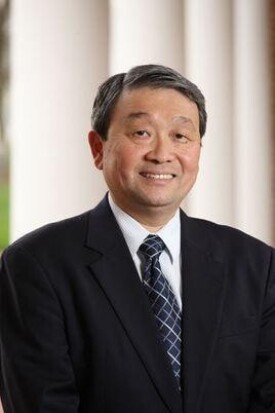共找到4條詞條名為陳明哲的結果 展開
- 國際管理學會前主席,動態競爭理論創始人
- 《民族美術》雜誌執行主編
- 台灣潛水專家
- 律師
陳明哲
國際管理學會前主席,動態競爭理論創始人
陳明哲,男,畢業於美國馬里蘭大學博士學位,現任美國維吉尼亞大學達頓商學院講座教授。
| 時間 | 院校 | 學位 |
| XX-1976年 | 台北大學 | |
| XX-1988年 | 美國馬里蘭大學 | 博士 |
現任美國維吉尼亞大學達頓商學院講座教授。
國際管理學會(Academy of Management)暨戰略管理協會(Strategic Management Society)終身院士。
是全球著名的企業戰略專家、動態競爭理論創始人。
曾擔任全球擁有近兩萬名會員的國際管理學會主席(2012-2013)
他是這個全球最具影響力的管理學術組織,成立68年以來第一位沒有在美國接受大學教育的主席。
曾先後任教於哥倫比亞大學商學院與賓夕法尼亞大學華頓商學院,其教學、研究與諮詢範圍橫越歐、美、亞三洲。
研究方面
著作甚豐,是第一位三度榮膺國際戰略管理學會最佳論文獎和頂級學術期刊《管理評論》最佳論文獎的學者,後來也擔任《管理評論》的副總編輯。也是全球華人企業戰略研究的先鋒。他整合西方科學與東方哲學觀點來探討競爭與合作關係的論文,被Journal of Management Inquiry推選為2008年最佳論文。此外,於1997 年在華頓商學院創辦了西方第一個以華人企業為研究對象的「全球華人企業發展中心」。他的著作《全球華人企業透視—世界企業經理導引》由哈佛大學商學院出版社出版,《外交事務》雙月刊曾評論推薦此書。中文版的《動態競爭》一書,分別由台灣智勝出版社與北京大學出版社出版,收錄了陳教授歷年來重要的十二篇學術論文與治學心得。
年在華頓商學院創辦了西方第一個以華人企業為研究對象的「全球華人企業發展中心」。他的著作《全球華人企業透視—世界企業經理導引》由哈佛大學商學院出版社出版,《外交事務》雙月刊曾評論推薦此書。中文版的《動態競爭》一書,分別由台灣智勝出版社與北京大學出版社出版,收錄了陳教授歷年來重要的十二篇學術論文與治學心得。

陳明哲
諮詢
諮詢方面,經驗豐富。他曾為多家著名的跨國企業(包括美國聯合技術、默克製藥、聯邦快遞、杜邦、美國鋁業、都福、友邦保險、鐵姆肯、摩根斯坦利、慕尼黑再保險、比歐西氣體,以及勞斯萊斯公司等)與杜克企業教育全球學習資源網路,提供戰略諮詢與高階經理人培訓,也於2009年培訓中國國務院國有資產監督管理委員會的重要骨幹企業領導人員。陳教授曾應邀參加2000年在北京由世界經濟論壇主辦的「中國企業高峰會」,2004年在紐約舉行的「美國—中國企業執行長高峰論壇」與在德國漢堡舉行的「中國—歐洲企業高峰會」,2006年與2007年分別在阿根廷布宜諾斯艾利斯、巴西聖保羅和義大利米蘭由HSM主辦的「世界商業論壇」,2007年在北京舉行的「中國CEO論壇」,以及2010年在上海舉行的「復旦管理學國際論壇」等國際高峰會,並擔任主講人。
媒體報道
陳教授的研究理念及活動見諸於世界主要媒體專訪及報導。其中包括《華爾街日報》、《金融時報》、《美國新聞與世界報導》、《今日美國》、《福布斯》、《新聞周刊》、CNNfn、路透社、《亞洲周刊》、《明報》、《人民日報》、中央電視台、《財富中文版》、《經濟日報》、《哈佛商業評論中文版》等。
管理學者培訓
陳教授長年致力於年輕管理學者的培訓。1997年與2006年曾二度應中國國家教委MBA指導委員會邀請,2004、2006與2007年曾三度應台灣國科會邀請,分別在北京與台北培訓當地的MBA管理教授。他也先後受邀擔任英國帝國理工學院、香港中文大學、台灣大學、政治大學、復旦大學、中山大學、北京大學及清華大學等多所學校的客座講習教授、諮詢顧問。
中華文化
陳教授出身台灣、祖籍福建,曾經投身大儒之門,修習四書五經、先秦諸子等中國古典著作,深得中華文化的精髓,並以此為底蘊應用於管理學術與實務。
核心概念
動態競爭(Competitive Dynamics)
動態競爭是以中華文化與哲學為根基,融合西方社會科學的長處,並經過三十年的淬鍊所形成的策略視角。它不像五力分析止於產業,也不像SWOT分析止於企業本身,而是把競爭進一步拆解到具體的行動層次。更明確地說,競爭的本質是廠商間一連串列動與響應的交換攻防過程,廠商的攻撃成效取決於對手的防守與回撃程度。因此,動態競爭觀點貫穿哲學/文化、系統性知識、案例/經驗及應用工具四個層次,幫助企業思考在採取行動前如何避免、降低或延緩對手的響應,如何事先預測對手的響應,以及如何洞察攻擊者的行動以便適切地反擊。
代表著作
• Chen, Ming-Jer and Danny Miller. 2012. “Competitive Dynamics: Themes, Trends, and a Prospective Research Platform,” Academy of Management Annals, 6 (1): 135-210.
雙融管理(Ambicultural Management )
現代世界已經由「西方領導東方(West Leads East)」轉向「西方遇見東方(West Meets East)」,新一代領導者與企業必須能融合東、西文化,取其最優、而避其最劣,對新思維抱持開放態度,超越全球化的差異與分隔,並有能力發現其它文化與商業典範的智能與長處,同時,也要能夠兼容合作與競爭,平衡社會公益與私人利益、人際信任與法律關係、團隊合作與個人成就,盡畢生之力同時追求專業成就與人文關懷的極致。具體來說,就是展現中華文化「人-我-合」的精神。
代表著作
• Chen, Ming-Jer and Danny Miller. 2011. “The Relational Perspective as a Business Mindset: Managerial implications for East and West,” Academy of Management Perspective, 25 (3): 6-18.
商業戰略(Business Strategy )
戰略是經過組織的整合與協調,被設計來管理外部環境、開拓核心能力並獲得競爭優勢的承諾與行動。戰略牽涉到選擇,選擇需要權衡利弊,然後做出取捨。如何取捨不僅要考慮組織的核心價值觀,也要從宏觀的角度思考如何實現目標、完成使命。戰略也必須有一致性和連貫性,而其關鍵就是專註,就是「精一」。精一有助於淬鍊企業家的戰略思維,平衡急迫性與重要性,以及短期與長期,幫助企業從宏觀的視角來思考如何整合所有經營活動,並平衡所有利益相關人。有好的戰略思維還必須搭配組織文化與執行力,才能提高組織效能,這就是我所強調的「文化-策略-執行」三環鏈。
專書著作
《Inside Chinese Business》
Chen, Ming-Jer. 2001/06. Inside Chinese Business: A Guide for Managers Worldwide, Harvard Business School Press.
“A guide for anyone who wants to engage the Chinese in cooperative endeavor.” – “Foreign Affairs.” Ming-Jer Chen takes readers “Inside Chinese Business” to reveal the social and cultural values that underpin Chinese business practices and influence day-to-day corporate decisions. Drawing from his intimate knowledge of Chinese culture and history and from his extensive managerial work and international experience, Chen provides an unrivaled insider’s perspective on how to work, compete, and cooperate successfully with Chinese companies around the globe
《動態競爭》
繁體版:陳明哲,2008,動態競爭。台北:智勝。(2010二版)
簡體版:陳明哲,2009,動態競爭。中國北京:北京大學出版社。
競爭分析是戰略管理的基本要素,但是,迄今許多學界與實務界人士仍僅採用產業結構分析之類的靜態分析架構。本書首次注意到廠商間競爭對抗的動態本質,將競爭性行動與響應視為兩個不同的概念,並且以廠商間實際的競爭互動為分析主體,藉此檢視一系列重要的競爭議題,進而建構了一個相互連貫的競爭性行為預測理論。
本書從各個層次(level)探討「何謂競爭?」、「誰是競爭者?」等基本的戰略議題,並且對廠商間競爭對抗的特質有精闢的分析。第一單元以競爭性行動與響應的對偶(dyadic)層次為焦點,探討如何預測與降低競爭者的競爭性響應。第二單元探討廠商(firm)層次的戰略性競爭行為,藉此了解競爭性行動與響應的前因與後果。第三單元將廠商戰略視為競爭性行動的決戰組合(repertoire),探討競爭性決戰組合之簡化、慣性及不一致性的影響原因與績效意涵。第四單元涵蓋動態競爭戰略的理論整合與方法運用,以及總體(corporate)層次的競爭分析。第五單元則說明動態競爭研究的方法論與研究過程的回顧。
本書提供了一套整合性的競爭分析架構,學界可以藉此了解如何發展一個創新的研究體系,以及如何有效管理研究歷程,實務界亦可運用本書的嚴謹架構與觀念進行更合乎實際的戰略分析,進而擬定可實現的動態競爭戰略。
學術文章
Chen, Ming-Jer and Danny Miller. 2012. “Competitive Dynamics: Themes, Trends, and a Prospective Research Platform,” Academy of Management Annals, 6 (1): 135-210.
Chen, Ming-Jer and Danny Miller. 2011. “The Relational Perspective as a Business Mindset: Managerial implications for East and West,” Academy of Management Perspective, 25 (3): 6-18.
Tsai, Wenpin, Kuo-Hsien Su, and Ming-Jer Chen. 2011. “Seeing Through the Eyes of a Rival: Competitor Acumen Based on Rival-Centric Perceptions,” Academy of Management Journal, 54: 761-778.
Chen, Ming-Jer, Hao-Chieh Lin, & John Michel. 2010. “Navigating in a Hypercompetitive Environment: The Roles of Action Aggressiveness and TMT Integration,” Strategic Management Journal, 31: 1410-1430.
Chen, Ming-Jer and Danny Miller. 2010. “West Meets East: Toward an Ambicultural Approach to Management,”Academy of Management Perspective, 24 (4): 17-24.
Chen, Ming-Jer. 2010. “Reflecting on the Process: Building Competitive Dynamics Research,” Asia Pacific Journal of Management, 27: 9-24.
Chen, Ming-Jer. 2009. “Competitive Dynamics Research: An Insider’s Odyssey,” Asia Pacific Journal of Management, 26: 5-26.
Chen, Ming-Jer. 2008. “Reconceptualizing the Competition-Cooperation Relationship: A Transparadox Perspective,” Journal of Management Inquiry, 17: 288-304 (this paper won the journal’s annual Breaking the Frame Best Paper Award).
Hambrick, Donald C. and Ming-Jer Chen. 2008. “New Academic Fields as Admittance-Seeking Social Movements: The Case of Strategic Management,” Academy of Management Review, 33:32-54.
Nag, Rajiv, Donald C. Hambrick and Ming-Jer Chen. 2007. “What is Strategic Management, Really? Inductive Derivation of a Consensus Definition of the Field,” Strategic Management Journal, 28:935-955.
Chen, Ming-Jer, Kuo-Hsien Su, and Wenpin Tsai. 2007. “Competitive Tension: The Awareness-Motivation-Capability Perspective,” Academy of Management Journal, 50:101-108.
Chen, Ming-Jer, S. Venkataraman, Sylvia S. Black, and Ian C. MacMillan. 2002. “The Role of Irreversibilities in Competitive Interaction: Behavioral Considerations from Organization Theory,” Managerial and Decision Economics, 23:187-207.
Chen, Ming-Jer. 2002. “Transcending Paradox: The Chinese “Middle Way” Perspective,” Asia Pacific Journal of Management, 19:179-199.
McGrath, Rita G., Ming-Jer Chen, and Ian C. MacMillan. 1998. “Multimarket Maneuvering in Uncertain Spheres of Influence: Resource Diversion Strategies,” Academy of Management Review, 23: 724-740.
Hambrick, Donald C., Theresa Cho, and Ming-Jer Chen. 1996. “The Influence of Top Management Team Heterogeneity on Firm’s Competitive Moves,” Administrative Science Quarterly, 41: 659-684.
Chen, Ming-Jer. 1996. “Competitor Analysis and Interfirm Rivalry: Toward a Theoretical Integration,” Academy of Management Review, 21: 100-134 (this paper won the journal’s annual Best Paper Award; an earlier version of this paper received the 1995 Glueck Best Paper Award of the Academy’s Business Policy and Strategy Division).
Miller, Danny and Ming-Jer Chen. 1996. “The Simplicity of Competitive Repertoires: An Empirical Analysis,”Strategic Management Journal, 17: 419-439. (lead article) (an earlier version of this paper received the 1993 Glueck Best Paper Award of the Academy’s Business Policy and Strategy Division.)
Miller, Danny and Ming-Jer Chen. 1996. “Nonconformity in Competitive Repertoires,” Social Forces, 74: 1209-1234.
Chen, Ming-Jer and Donald C. Hambrick. 1995. “Speed, Stealth, and Selective Attack: How Small Firms Differ from Large Firms in Competitive Behavior,” Academy of Management Journal, 38: 453-482.
Chen, Ming-Jer and Danny Miller. 1994. “Competitive Attack, Retaliation and Performance: An Expectancy-Valence Framework,” Strategic Management Journal, 15: 85-102 (lead article).
Miller, Danny and Ming-Jer Chen. 1994. “Sources and Consequences of Competitive Inertia: A Study of the U.S. Airline Industry,” Administrative Science Quarterly, 39: 1-23.
Chen, Ming-Jer, Jiing-Lih Farh, and Ian C. MacMillan. 1993. “An Exploration of the Expertness of Outside Informants,” Academy of Management Journal (Special Research Forum on Methodology), 36: 1614-1632.
Chen, Ming-Jer and Ian C. MacMillan. 1992. “Nonresponse and Delayed Response to Competitive Moves: The Roles of Competitor Dependence and Action Irreversibility,” Academy of Management Journal, 35: 539-570.
Chen, Ming-Jer, Ken G. Smith, and C.M. Grimm. 1992. “Action Characteristics as Predictors of Competitive Responses,” Management Science, 38: 439-455.
Smith, Ken G., C.M. Grimm, M.J. Gannon, and Ming-Jer Chen. 1991. “Organizational Information Processing, Competitive Responses and Performance in the U.S. Domestic Airline Industry,” Academy of Management Journal, 34: 60-85.
Smith, Ken G., J.P. Guthrie, and Ming-Jer Chen. 1989. “Strategy, Size and Performance,” Organization Studies, 10: 63-81.
Smith, Ken G., C.M. Grimm, Ming-Jer Chen, and M.J. Gannon. 1989. “Predictors of Response Time to Competitive Strategic Actions: Preliminary Theory and Evidence,” Journal of Business Research, 18: 245-258.
1.Chen, Ming-Jer and Danny Miller. 2012. “Competitive Dynamics: Themes, Trends, and a Prospective Research Platform,” Academy of Management Annals, 6 (1): 135-210.
2.Chen, Ming-Jer and Danny Miller. 2011. “The Relational Perspective as a Business Mindset: Managerial implications for East and West,” Academy of Management Perspective, 25 (3): 6-18.
3.Tsai, Wenpin, Kuo-Hsien Su, and Ming-Jer Chen. 2011. “Seeing Through the Eyes of a Rival: Competitor Acumen Based on Rival-Centric Perceptions,” Academy of Management Journal, 54: 761-778.
4.Chen, Ming-Jer, Hao-Chieh Lin, & John Michel. 2010. “Navigating in a Hypercompetitive Environment: The Roles of Action Aggressiveness and TMT Integration,” Strategic Management Journal, 31: 1410-1430.
5.Chen, Ming-Jer and Danny Miller. 2010. “West Meets East: Toward an Ambicultural Approach to Management,”Academy of Management Perspective, 24 (4): 17-24.
6.Chen, Ming-Jer. 2010. “Reflecting on the Process: Building Competitive Dynamics Research,” Asia Pacific Journal of Management, 27: 9-24.
7.Chen, Ming-Jer. 2009. “Competitive Dynamics Research: An Insider’s Odyssey,” Asia Pacific Journal of Management, 26: 5-26.
8.Chen, Ming-Jer. 2008. “Reconceptualizing the Competition-Cooperation Relationship: A Transparadox Perspective,” Journal of Management Inquiry, 17: 288-304 (this paper won the journal’s annual Breaking the Frame Best Paper Award).
9.Hambrick, Donald C. and Ming-Jer Chen. 2008. “New Academic Fields as Admittance-Seeking Social Movements: The Case of Strategic Management,” Academy of Management Review, 33:32-54.
10.Nag, Rajiv, Donald C. Hambrick and Ming-Jer Chen. 2007. “What is Strategic Management, Really? Inductive Derivation of a Consensus Definition of the Field,” Strategic Management Journal, 28:935-955.
11.Chen, Ming-Jer, Kuo-Hsien Su, and Wenpin Tsai. 2007. “Competitive Tension: The Awareness-Motivation-Capability Perspective,” Academy of Management Journal, 50:101-108.
12.Chen, Ming-Jer, S. Venkataraman, Sylvia S. Black, and Ian C. MacMillan. 2002. “The Role of Irreversibilities in Competitive Interaction: Behavioral Considerations from Organization Theory,” Managerial and Decision Economics, 23:187-207.
13.Chen, Ming-Jer. 2002. “Transcending Paradox: The Chinese “Middle Way” Perspective,” Asia Pacific Journal of Management, 19:179-199.
14.McGrath, Rita G., Ming-Jer Chen, and Ian C. MacMillan. 1998. “Multimarket Maneuvering in Uncertain Spheres of Influence: Resource Diversion Strategies,” Academy of Management Review, 23: 724-740.
15.Hambrick, Donald C., Theresa Cho, and Ming-Jer Chen. 1996. “The Influence of Top Management Team Heterogeneity on Firm’s Competitive Moves,” Administrative Science Quarterly, 41: 659-684.
16.Chen, Ming-Jer. 1996. “Competitor Analysis and Interfirm Rivalry: Toward a Theoretical Integration,” Academy of Management Review, 21: 100-134 (this paper won the journal’s annual Best Paper Award; an earlier version of this paper received the 1995 Glueck Best Paper Award of the Academy’s Business Policy and Strategy Division).
17.Miller, Danny and Ming-Jer Chen. 1996. “The Simplicity of Competitive Repertoires: An Empirical Analysis,”Strategic Management Journal, 17: 419-439. (lead article) (an earlier version of this paper received the 1993 Glueck Best Paper Award of the Academy’s Business Policy and Strategy Division.)
18.Miller, Danny and Ming-Jer Chen. 1996. “Nonconformity in Competitive Repertoires,” Social Forces, 74: 1209-1234.
19.Chen, Ming-Jer and Donald C. Hambrick. 1995. “Speed, Stealth, and Selective Attack: How Small Firms Differ from Large Firms in Competitive Behavior,” Academy of Management Journal, 38: 453-482.
20.Chen, Ming-Jer and Danny Miller. 1994. “Competitive Attack, Retaliation and Performance: An Expectancy-Valence Framework,” Strategic Management Journal, 15: 85-102 (lead article).
21.Miller, Danny and Ming-Jer Chen. 1994. “Sources and Consequences of Competitive Inertia: A Study of the U.S. Airline Industry,” Administrative Science Quarterly, 39: 1-23.
22.Chen, Ming-Jer, Jiing-Lih Farh, and Ian C. MacMillan. 1993. “An Exploration of the Expertness of Outside Informants,” Academy of Management Journal (Special Research Forum on Methodology), 36: 1614-1632.
23.Chen, Ming-Jer and Ian C. MacMillan. 1992. “Nonresponse and Delayed Response to Competitive Moves: The Roles of Competitor Dependence and Action Irreversibility,” Academy of Management Journal, 35: 539-570.
24.Chen, Ming-Jer, Ken G. Smith, and C.M. Grimm. 1992. “Action Characteristics as Predictors of Competitive Responses,” Management Science, 38: 439-455.
25.Smith, Ken G., C.M. Grimm, M.J. Gannon, and Ming-Jer Chen. 1991. “Organizational Information Processing, Competitive Responses and Performance in the U.S. Domestic Airline Industry,” Academy of Management Journal, 34: 60-85.
26.Smith, Ken G., J.P. Guthrie, and Ming-Jer Chen. 1989. “Strategy, Size and Performance,” Organization Studies, 10: 63-81.
27.Smith, Ken G., C.M. Grimm, Ming-Jer Chen, and M.J. Gannon. 1989. “Predictors of Response Time to Competitive Strategic Actions: Preliminary Theory and Evidence,” Journal of Business Research, 18: 245-258.
